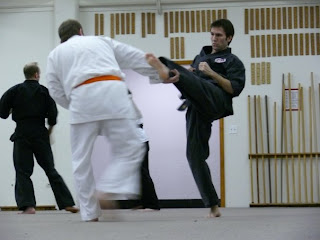Post By: Sensei Lee
Keep in mind that while I have earned the rank of 2nd degree black belt in karate, that in Aiki I'm an orange belt. So I apologize ahead of time if this post is incorrect and shows my Aiki ignorance. I hope that any Aiki readers will correct me if this comes out wrong.
The other night in Aiki Sensei Dawn put us through a pretty grueling practice. In circle attack fashion we had to go through three techniques in order with the attackers punching 1-8. Not only is it difficult to remember where you are in the sequence and to correctly perform the needed technique, but it is also hard on the attackers. Attackers need to pop up from a throw quickly in order to provide the next punch. Sensei Dawn pointed out near the end of this practice that the Aiki black belts were breathing normally. Meanwhile, the lower belts (myself included) were out of breath and dripping with sweat.
It amazes me how little physical exertion and effort are needed in Aiki when the techniques are done correctly. Granted, sometimes I want to push myself in practice in order to get a decent "workout." Unfortunately, I don't have time to make it to a gym and then to practice, so martial arts remain my primary form of exercise. However, having the ability to choose when to push yourself in terms of exertion and when to let the Aiki work for you, now that sounds like a great ability to have.
Photo By: Ken Smith






















